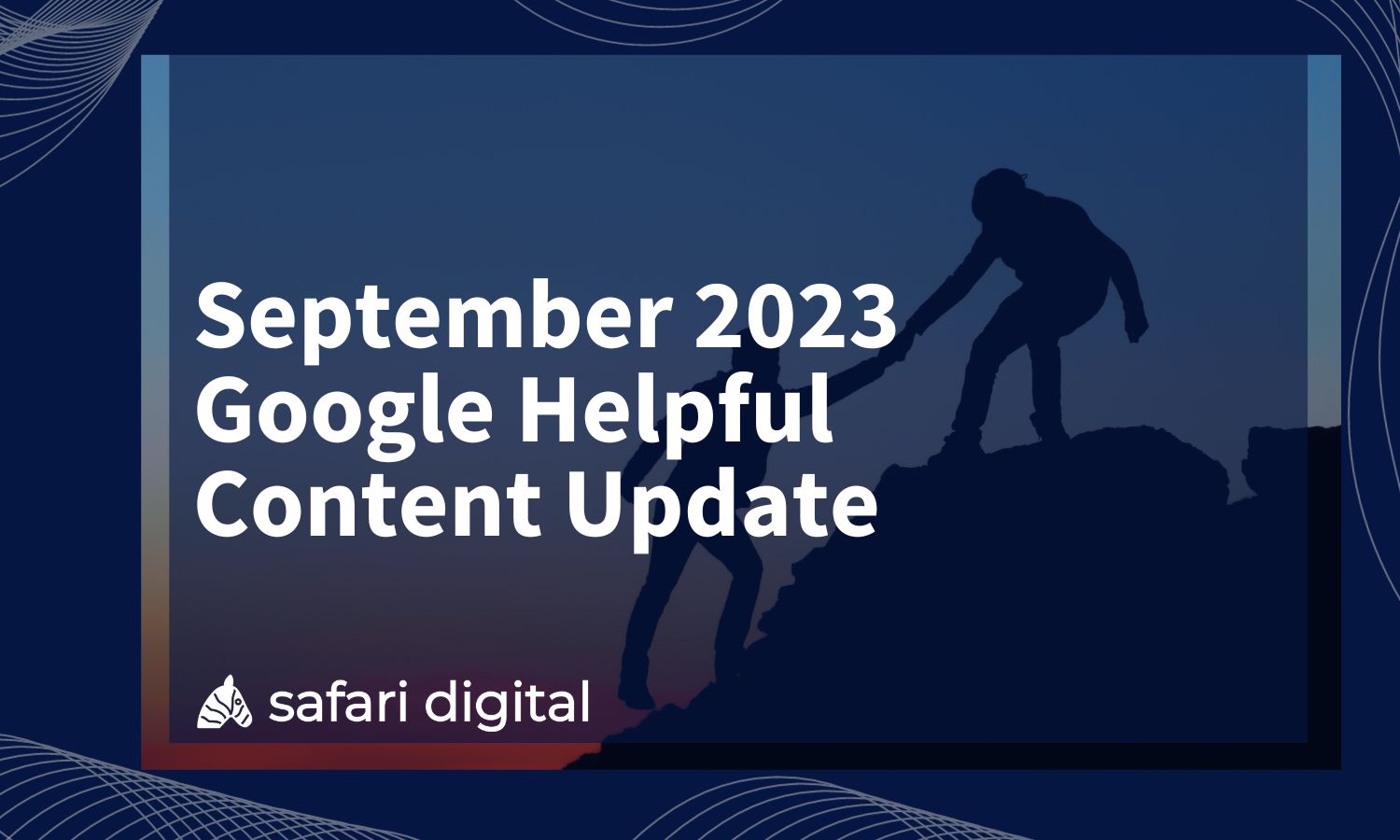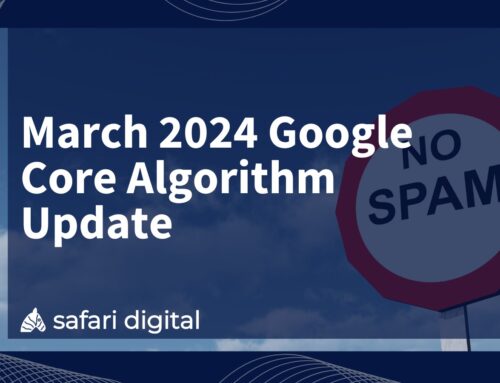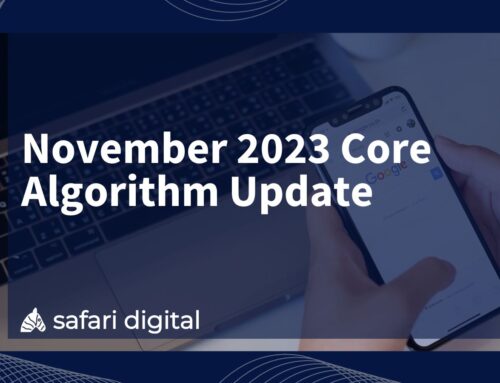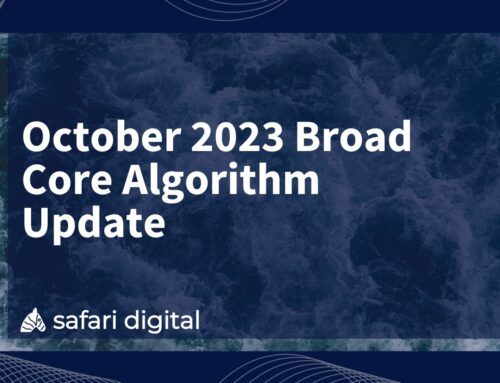
Google announced the September 2023 Helpful Content on the 14th September 2023.
The September 2023 helpful content update is expected to take two weeks to fully roll out and follows the last helpful content update back in December 2022.
The announcement
“The September 2023 helpful content update is rolling out with an improved classifier. It will take about two weeks to complete. We’ll update our ranking release history page when the rollout is complete.”
What does this all mean?
Well, it means that Google is making some changes to its helpful content rating system and you (I presume you’re in the industry if you’re reading), should take notice.
The latest algorithm update comes just weeks after the August 2023 Broad Core Algorithm update with two key changes to content quality guidelines, and one important change to how subdomains are used by websites.
So then, we’re going to break down this update into three key points. Skip to the points that affect you (likely the content parts) and skip the subdomains part if it’s not your thing.
September 2023 helpful content update table of contents
- Changes to Machine Generated Content Guidance
- Warning around faking “content freshness”
- Warning about 3rd part content on subdomains
What is a helpful content update?
Before we jump into it, a bit of housekeeping for new readers.
A helpful content update is, as the name suggests, a shift in the way that Google defines and determines what constitutes helpful content. In their continued efforts to make search results relevant and valuable for users, Google uses these updates to flag key changes to the content quality system that is used as part of the search ranking algorithm.
Google’s helpful content update targets content that is generated for the sole purpose or ranking well in search engines.
While it seems crazy, there is method to the madness. Google uses helpful content updates as an opportunity to reward content that is designed to help or inform people, rather than content that has been generated to ‘game’ the system and rank well in Google.
Update 1: Helpful Content & Machine Generated Content Updated Guidance
For us, this is the most significant change to come out of the latest helpful content algorithm update from Google.
Yes, you’ve got to read carefully to find the difference, but for anyone with the ability to read between the lines and understand the power of what is not said by Google, then you’ll know that this is a big one.

Google’s previous guidance on AI content
“Google Search’s helpful content system generates a signal used by our automated ranking systems to better ensure people see original, helpful content written by people, for people, in search results.”
Google’s updated guidance on AI content
“Google Search’s helpful content system generates a signal used by our automated ranking systems to better ensure people see original, helpful content created for people in search results.”
Looks the same, what changed?
Well, in terms of wording, there wasn’t a great deal. However, read between the lines and you’ll notice the omission of three significant words:
“written by people”
Not such a big deal, right?
Well, I’m not so sure about that.
The previous guidance from Google placed an emphasis on human generated content in determining helpful content.
With the influx of AI generated content making its way onto websites since Chat GPT hit the mainstream in late 2022/early 2023, it appears that Google may be changing its tone around machine generated/AI content.
So then, time to lay off your content team and double down on AI architects?
Maybe, but maybe hold off for just a little longer.
As an SEO agency, we’ve seen the front-line effects of websites going hard on AI content for the better part of a year.
Before Chat GPT, we had the Jasper crowd that were pumping out garbage content. Yes, the guard has shifted, the pay walls have lifted, but the outcome very much remains the same.
The majority of content that is written by machines/AI lacks, for one of a better word, accuracy.
Whilst this change shouldn’t come as a huge surprise, it should be noted that this means very little for garbage AI content offenders.
Site owners and SEOs that are cutting corners, missing facts, and littering the SERPs with generic, AI-generated content that provides no value to readers can expect to feel the full wrath of Google’s content-quality rater system.
Put it this way, if someone with little to no subject knowledge can curate the same content that subject experts are putting on their website, then you’ve got a problem.
Our guidance?
Hold off on the AI content and leave it to the subject experts – for now at least.
Update 2: Warning around faking “content freshness”
Google made some key changes to the Helpful Content Self-Assessment guidance, Creating helpful, reliable, people-first content.
Again, some seemingly small changes mean a lot for publishers and should be taken rather seriously.
1. Written by an expert becomes written OR reviewed by an expert
Old guidance
Is this content written by an expert or enthusiast who demonstrably knows the topic well?
New Guidance
Is this content written or reviewed by an expert or enthusiast who demonstrably knows the topic well?
Small changes, big implications.
So then, reading between the lines, does this mean that author profiles are now less important? Perhaps.
In other words, what Google is saying is that the outcome may now be more important than the method used to get there.
To us, the weighting system may be shifting away from the perceived topical authority of the author, and towards the quality of the content. Having a strong name and reputation may not be as important as the quality of information that is provided.
2. Faking updates to pages
It’s one of the most overused tricks in the grey hat SEO playbook, and it looks like Google is now going to be cracking down on offenders.
New guidance
“Are you changing the date of pages to make them seem fresh when the content has not substantially changed?”
Changing the publish date, making small changes to the date (the December rush to change articles from “Best of *Current Year*” to “Best of *Next Year*” could be wearing thin.
Our advice?
The days of changing the dates on pages, making tiny tweaks, or simply going through and changing the dates used in meta data to see ranking improvements are coming to a close.
3. Faking content freshness
Just like changing dates, the SEO boost that can (sometimes) be experienced by adding or removing content to a page (without providing any real value) may be expiring.
New guidance
“Are you adding a lot of new content or removing a lot of older content primarily because you believe it will help your search rankings overall by somehow making your site seem “fresh?” (No, it won’t)”
Our thoughts?
Going back and updating old content with new information is never a bad thing. For instance, having an evergreen piece of content that is substantiated with new data or developments isn’t a bad thing – just make sure the changes made quantify the update.
Update 3: Warning about 3rd part content on subdomains
Ok, so this one won’t be relevant to all, but the third (and final) substantial update from the September 2023 helpful content algorithm update comes in the form of a warning.
Gary Illyes, one of Google’s best known webmaster trends analysts and voices of the Google Search team, provides some important background on the phenomenon of sites that are essentially “renting out” their subdomain to third parties.
Excerpt from Gary Illyes on LinkedIn
“We’ve heard (and also noticed) that some sites “rent out” their subdomains or sometimes even subdirectories to third-parties, typically without any oversight over the content that’s hosted on those new, generally low quality micro-sites that have nothing to do with the parent site.
In fact the micro-sites are rarely ever linked from the parent sites, which don’t actually want to endorse these often questionable sites.
The only reason the owners of these shady (?) micro-sites rent the sub-spaces is to manipulate search results.”
In essence, this means that websites that are renting out their subdomains to third parties who benefit from the authority of these parent sites, could see the content used on subdomains counted as a quality rater towards their overall content.
Let’s say that a powerful publisher is renting out their subdomain to an affiliate style website, well, this means that the publisher could now see the content on the subdomain affect their overall quality score.
Moral of the story?
If you wouldn’t be comfortable posting the content that appears on your sub-domain on your main website, then you probably should be posting it.
Recovering from a helpful content update
Alright, so most of these articles normally end with a “if you’ve been impacted, refer back to Google’s guidance” which can be a somewhat vague (and not especially helpful) sign off.
Well, if you’ve been affected by the September 2023 Helpful Content Update from Google, you’ll be pleased to see that Google added a new paragraph to their helpful content guidance doc which is pleasingly actionable.
New guidance on recovering from a helpful content update
“If you’ve noticed a change in traffic you suspect may be related to this system (such as after a publicly-posted ranking update to the system), then you should self-assess your content and fix or remove any that seems unhelpful.
Our help page on how to create helpful, reliable people-first content has questions that you can use to self-assess your content to be successful with the helpful content system.”
So there you go.
No ambiguous sign off. If you’ve been impacted by the September 2023 helpful content update, then it’s time to prune, rethink, and improve your content.







